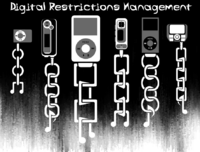Digital restrictions management
Digital restrictions management is a blanket term covering copy protection and any other forms of digital restrictions forbidding the unintended use of a digital product. It is also known under the name digital rights management, because it claims to protect the content publisher's rights; the acronym DRM is also frequently used for both terms.
Within the context of iPods, this is especially relevant since they do not have support for most music streaming services (e.g. Apple Music) specifically for this reason. Although some forms of digital restrictions management have been successfully bypassed or cracked before, including Super Audio CD (SACD), DVD-Video, Blu-Ray, and Widevine L3, other forms, most notably Spotify and Apple Music copy protection, have not been cracked, and therefore the content can only be extracted via lossy-to-lossless transcoding (which wastes lots of storage space) or lossy-to-lossy transcoding (which reduces quality even further).
iTunes prior to 2009 as well as Apple Music since 2015 uses digital restrictions management. These files are encoded under the .m4p extension, which is similar to .m4a AAC audio, plus the restrictions themselves. For iTunes purchases prior to 2009, with the exception of iTunes Plus-branded music sold between 2007 and 2009, it is possible to remove the DRM by deleting and re-downloading the music from the iTunes Store.
The inclusion of digital restrictions management have been criticized for violating fair use laws and other consumer rights. People opposed to DRM often state that it does not help fend off copyright infringement, and instead only inconveniences legitimate customers. DRM can also restrict users from exercising their legal rights under the copyright law, such as backing up copies of CDs or DVDs (instead having to buy another copy, if it can still be purchased), lending materials out through a library, accessing works in the public domain, or using copyrighted materials for research and education under the fair use doctrine. On the other hand, proponents of DRM, especially the Recording Industry Association of America (RIAA), state that it is a necessity in order to protect artists' rights, despite evidence proving to the contrary.
References
[1] "The pros, cons, and future of DRM". CBC. 7 August 2009. Retrieved 7 January 2012. "Digital locks – also known as digital rights management (DRM) technologies or technological protection measures (TPM)"
